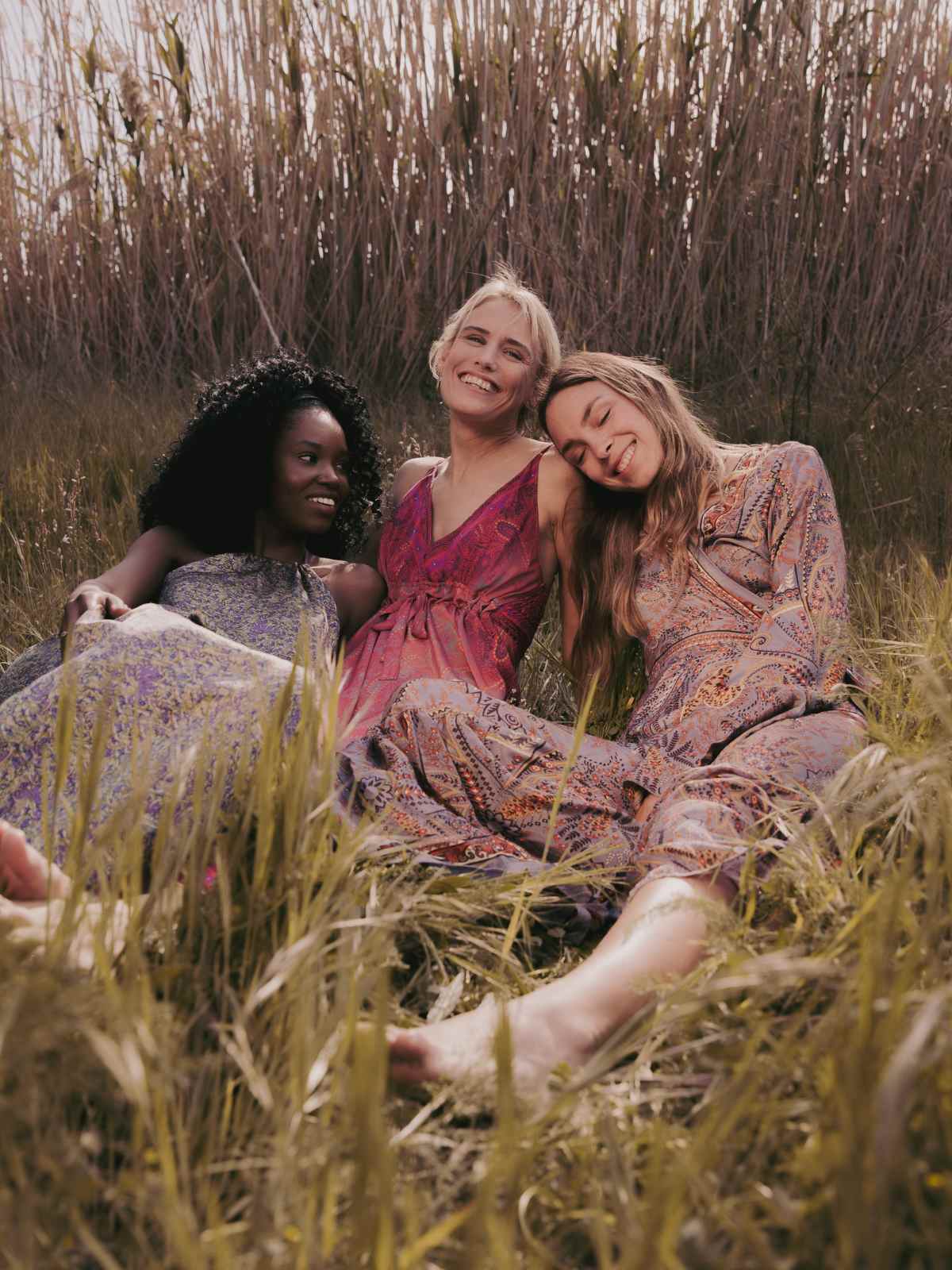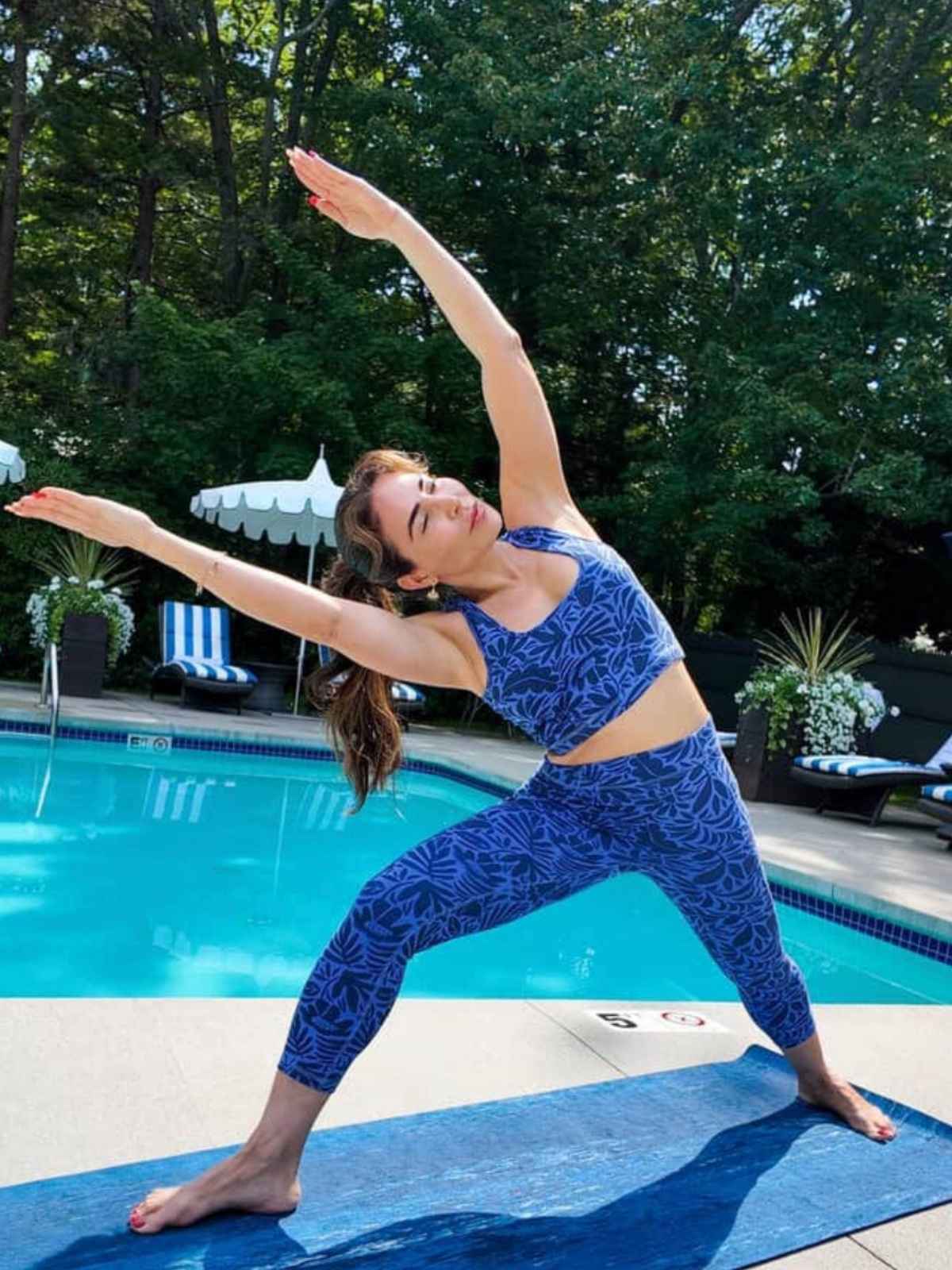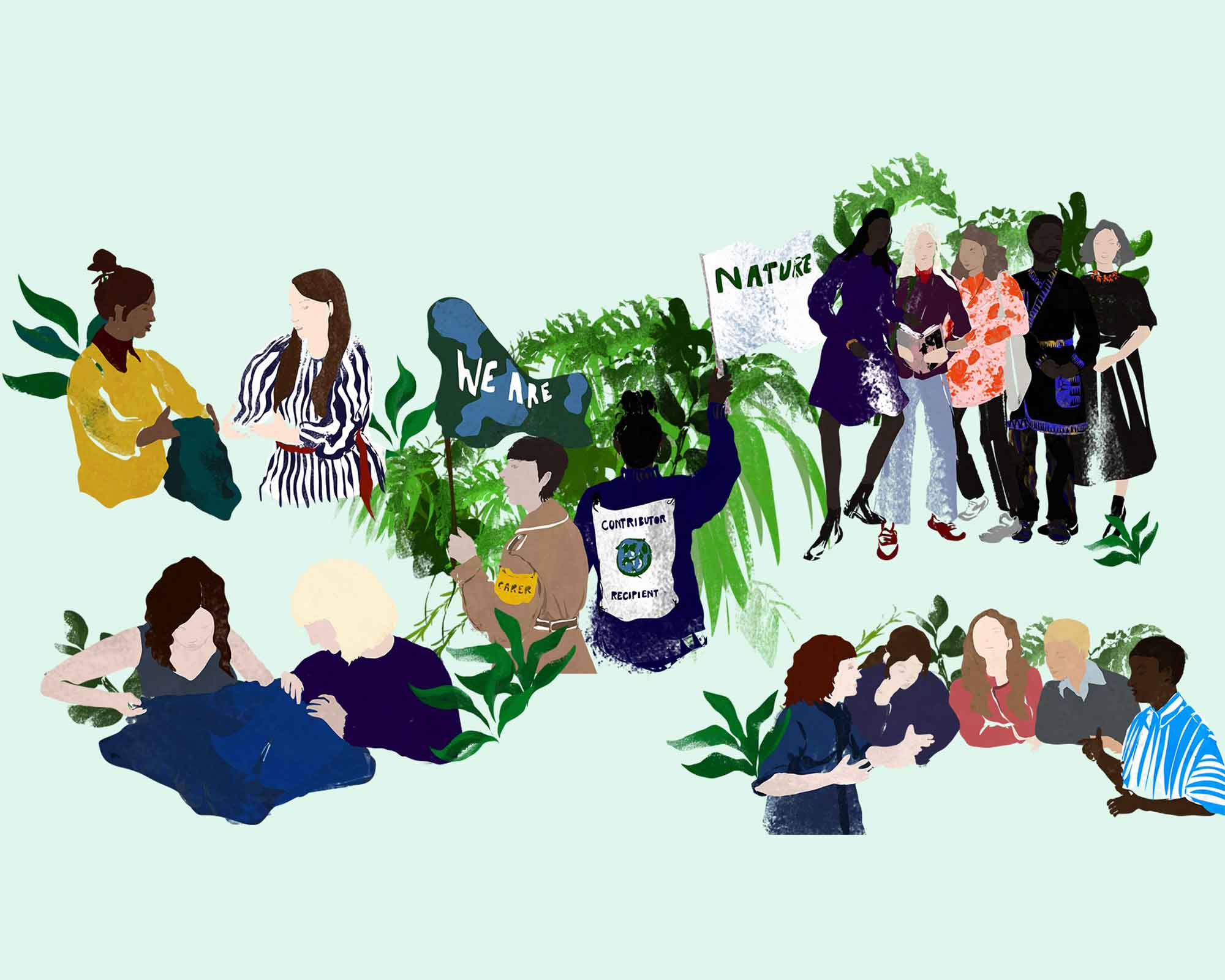If you’re like us, fashion’s alarming connection to the climate emergency and human rights abuses might have you wondering how a better industry could look. So we brought together 11 young voices, rising designers, and leading researchers to share their dreams for making the future of fashion more sustainable.
What’s the future of fashion?
Every time the major fashion weeks wrap up in hubs like London and New York City, we get a wave of predictions based on what’s spotted on the runway and in the streets. Colours, materials, and silhouettes get sorted into what’s in and what’s out—driving the treadmill of trends that seems to move faster with each season.
Today, styles churn at a feverish pace, with looks from the catwalk and our TikTok feeds turning over in a blink. Fast fashion brands, in particular, seem to have a new answer for what’s next every week—adding up to billions of garments produced each month that inevitably land in mountains of waste in countries like Ghana, Burkina Faso, and Côte d’Ivoire.
At this point, the industry’s obsession with trends comes off as not only unimaginative but dangerously out of touch. The future we need is not one where sustainability is a mere sidebar to business as usual. The more you educate yourself on fashion’s impacts on the climate emergency and big brands’ human rights records, the more you see we need to re-envision the entire system—a system that, for example, fuels profits for a few white billionaires while millions of garment workers remain trapped in poverty.
That’s why, as Paris Fashion Week marks the end of 2021’s major shows, we’re not focused on the must-shop trends. Instead, we’re pausing to question what a more sustainable future for fashion could look like.
For some fresh views, we tapped Centre for Sustainable Fashion (CSF) at London College of Fashion, University of the Arts London, one of the leading research centres in the world focused on challenging fashion’s status quo. We invited rising voices, advocates, and leading researchers to dream big with us—asking, “If you could define one element of fashion’s future, what would you change?”
These 11 future of fashion perspectives range from the specific to the holistic, from augmented reality exposing fast fashion retailers to redistributing the exploitative systems of power that define modern fashion. Connecting the dots between them, the scope of the problems we face becomes clear—and a manifesto emerges for a more hopeful future.
End the trend cycle
Aniela Fidler Wieruszewska, designer and maker
We should pay more attention to extending a product’s lifetime and alter the destructive pattern of the current trend-led clothing life cycle.
The fashion industry operates at high speed, benefiting from ferociously short production cycles and ever-changing trends chasing future and newness. Most fashion products are designed for obsolescence, and their perceived value peaks at the moment we buy them.
We need different narratives and behaviours—ones that orient fashion towards longevity and the preservation of nature and human experience. Creating alternative, longevity-focused value models requires new ways of appreciating.
I think marketing plays an important role in the way we use and think about clothes. I have a lot of interest in communication, how it influences our behaviours, and how it could be lessening our appetite for unreflective consumption—and consequently, the destruction of the planet.
Growth ≠ success
Natasha Mays, student
I truly believe that imagination is just the step before making something a reality, and so the one thing I would change is the fashion industry’s connection to human beings—through society and culture. Fashion’s idea of growth as a marker of success perpetuates slavery, appropriation, racism, shallow values, and financial burdens. Without change in these areas, truly sustainable fashion will remain a privilege for those who are not marginalised by race, education, or wealth.
It matters to me because, as a woman of colour, I have been fortunate to have the privilege of a good and continuing education, which has afforded me opportunities to ‘see the world’ more speculatively. It sounds cheesy, but I try to be the change I want to see and use my privilege and creativity to shine a light on issues that affect the future of my community through sustainable methods—working with textile waste, natural dyes, and upcycling.
We need different narratives and behaviours—ones that orient fashion towards longevity and the preservation of nature and human experience.
Aniela Fidler Wieruszewska – designer and maker
No more clothes in landfills
Sandy Black, Professor of Fashion & Textile Design and Technology
I started my sustainability journey through an abhorrence of waste. Before working in academia, I ran my own small business as a knitwear designer and producer, selling to prestigious stores worldwide. I understand firsthand what it means to run a design-led business.
Fashion is still an endemically wasteful and largely craft-based industry, and I would like to see many things scaling and converging to achieve a more sustainable future of fashion, for example:
- No more clothes go to landfills. The infrastructure is everywhere to enable easy take back, swapping, and repurposing of used garments and eventual recycling when worn out through large scale success of textile-to-textile recycling processes.
- We unlearn cheap fashion. Prices have been artificially lowered in the mass market’s ‘race to the bottom’. Prices need to rise to reflect the true costs and value. We need a revaluing of fashion and the payment of living wages across the workforce. A living wage would not in itself impact the end price too much.
- Reduction in overproduction and mindless consumption. I want to see the transition to effective made-to-order and small batch production systems as standard to increase people’s love for their clothes, resulting in longer use.
- Support for micro and small fashion businesses innovating for sustainability. Incentivise small sustainable fashion businesses through tax breaks, and level the playing field compared to large companies or others not demonstrating sustainable practices. That way, creativity and social justice can thrive in diverse local communities.
Redistribute the power
Dilys Williams, Professor of Fashion Design for Sustainability and Director at CSF
I would change the distribution of power in fashion, so that fashion’s cultural, social, economic, and ecological value was equally spread across all of life.
It matters to me because I respect our interbeing, a word that Tibetan monk Thich Nhat Hanh uses to express the interconnectedness of all things.
Nature- and equity-first education
Nina Stevenson, educator
Fashion education must acknowledge our complicity in ecological collapse and social inequity. Through education, the role of fashion design, business, and media can be explored safely and radically restore and regenerate our social, economic, cultural, and ecological systems.
So I would love to imagine a world where everyone engaged in fashion has access to education that considers fashion from a nature- and equity-first viewpoint. A world where we have the time and space to connect with and learn from others, and we can design fashion products, systems, and services that are nurturing well-being for nature and people, and not just nurturing the wealth of a handful of individuals at the expense of our planet.

Intervene in overconsumption
Anna Fitzpatrick, lecturer and PhD candidate
I am interested in exploring and intervening in the idea of fashion as consumption. Of course, fashion is about more than shopping, but much of the unsustainability of fashion is linked to the speed and volume at which it is produced and consumed.
With this in mind, I would hope to change our understanding of ourselves and our place in the world so we can recognise how important our relationships with one another, the non-human world, and ourselves truly are. Then we can recognise when we turn to shopping as a balm for our emotions, for a sense of agency, or as a form of escape. When we learn to understand these desires, our ideas about success and connection may shift and then perhaps our shopping habits will, too.
Redefine what we value
Naomi Bulliard, Head of Strategy at CSF
I would like to redefine how we value our contributions as human beings to the fashion industry—redefining what is of value and to whom. Not defining success by efficiency or proficiency alone but by care for each other, the planet, and its species.
I like the idea of moving away from creating more of what Margaret Heffernan describes as ‘super chickens’ and instead valuing each other’s contributions. Moreover, moving away from human imposition to a more equitable planet decentred from human-centred everything.
In terms of sustainable fashion, this means that economic gains alone or production efficiency will not mean anything if biodiversity and human equity are negatively impacted. What matters to me is our interconnection with each other on and with the planet and seeing our multiplicity as an asset. I think our commitments should be defined by the positive impact they can have on each other as human beings and with other species and nature.
Using technological innovation for good, we can chart future visions of making shopping a more ethical, transparent, and fun experience.
Vishal Tolambia – multi-disciplinary fashion designer; founder, Humanity Centred Designs
Tech to filter the greenwashing
Vishal Tolambia, multi-disciplinary fashion designer; Founder, Humanity Centred Designs; sustainability research student
Transparency—a term lately used by every brand. I feel there is still a lack of transparency even though every brand claims to have sustainable values, ethics, and commitments. Brands are failing to provide consumers with enough information. Every consumer has their commitments and goals in terms of sustainable products, but they find it difficult when it comes to making a better choice due to a lack of understanding and supply chain visibility about particular products.
Now, let’s imagine harnessing the power of emerging technologies such as artificial intelligence and augmented reality for good. That could transform the fashion industry and bring genuine transparency. It’s a new vision of the future in which users can access the real-time brand supply chain information, as well as provide a mechanism to match with products that share similar personal sustainable values and commitments to find a perfect match. I’ve channelled these ideas into a speculative project of fashion dating called ‘Fashion Affair.’
No doubt new technological innovations have already started to shift the business paradigm of the fashion industry. But I believe we must think beyond present boundaries. Using technological innovation for good, we can chart future visions of making shopping a more ethical, transparent, and fun experience.
Stop focusing on ‘doing less bad’
Sarah Needham, Knowledge Exchange Manager at CSF
I would like the future of fashion to redefine desirability and foster a desire for materials that respect nature, a desire for craftsmanship, a desire for longevity that transcends fleeting trends. The fashion industry does not currently accurately account for the natural resources and work that go into creating pieces that all too often only stay in our wardrobes for a matter of weeks or months.
The relationship between the fashion industry and the climate emergency is increasingly well understood. A few brands and retailers have taken steps to rectify some of these wrongs. However, they still operate on a business model based on growth and overproduction. We need to stop focusing on ‘doing less bad’ and redefine success factors with entirely new ways of doing business.
Fashion school = sustainability school
Julia Crew, Course Leader at CSF
If I could make one change it would be to see sustainability seamlessly integrated into all fashion courses. Whilst we have made huge progress in the last few years, there is still more we can do. Such education can provide students—who are the fashion designers, makers and business leaders of the future—with the essential ecological and ethical literacy to redefine the fashion industry. I believe empowering students with this knowledge can lead to a future where fashion recognises and respects planetary boundaries and the equity of all people and living things.
Fashion as community service
Emily Taylor, MA student and designer
Fashion is not just about clothes. I would like to see it redefined from its current status as a commodity to be seen as a service that supports values of co-creation, creative expression, and community. Too often, we focus on the commercial appeal of a garment, forgetting the many layers of value it represents socially, culturally and symbolically.
My perspective is from the fast fashion industry, an industry obsessed with product. If service was the focus of fashion, then upcycling, garment sharing, skills networks, repair, and customisation, amongst many others, could become integrated into our experience of clothing.
An item of clothing itself is not always the thing of value, but rather it is the story of a garment, how it was made, and the memories attached to it that can create value for the wearer. It is possibly a utopian dream, but I believe that if we focused on why people genuinely connect with fashion and worked on ways to offer these instead of simply more products, it could lead to a more sustainable future.



















